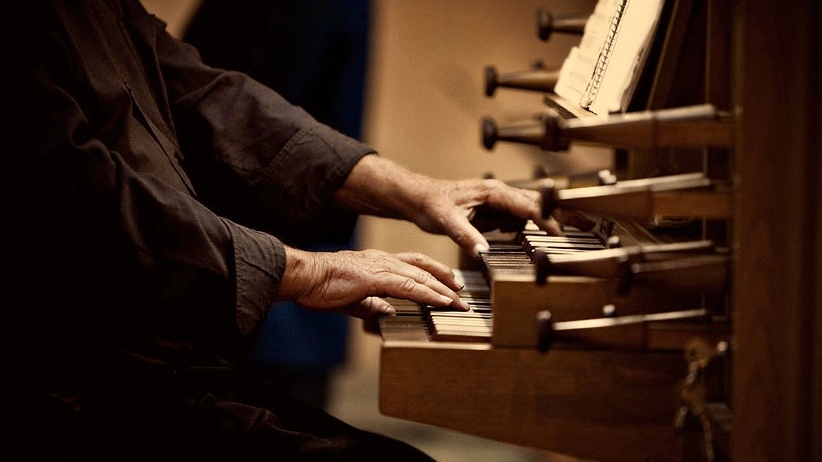A few weeks ago I was at the perfect wedding. My young friend Will Heaven, a comment editor at the Telegraph, married the beautiful Lida Mirzaii, his girlfriend since university. The service was in Wardour Chapel in Wiltshire, a neoclassical masterpiece described by Pevsner as ‘so grand in its decoration that it seems consciously to express the spirit of the Catholic ecclesia triumphans’. Most of the guests were in their mid-twenties and doing their best to control their boisterousness. The Oratorian priest wore an antique cope; if it had been a Mass he might have been allowed to borrow the chasuble in the sacristy believed to have been worn by Cardinal Wolsey at the Field of the Cloth of Gold.
Will was a boy chorister at Salisbury so the choice of hymns was spot on. But the music at weddings lives or dies at the hands of the organist (in my youth I wrecked quite a few with my approximation of Mendelssohn’s Wedding March) and here Will took no chances. Edward Tambling, assistant director of music at Spanish Place, has the most impeccable technique and judgment. As an organ scholar at Westminster Abbey, he got into hot water for using ‘colourful language’ on a Facebook page to describe the nauseating clotted harmonies of John Rutter. Good man!
As we took our places, out roared my favourite E-flat major chord — the opening of Bach’s ‘St Anne’ Prelude and Fugue BWV 552. Nothing in Bach’s organ music surpasses the grandeur of this work. Confusingly, the prelude and the fugue weren’t originally published as a pair but were placed on either side of a collection of the composer’s finest chorale preludes: the whole is known as the Clavier-Übung III, or ‘German Organ Mass’. They form musical bookends, in other words — but they also create an overwhelming effect when joined together, as they are in organ recitals.
The English nickname ‘St Anne’ came about because the fugue begins with a subject that matches the first line of the hymn tune known as ‘St Anne’ — ‘O God Our Help in Ages Past’. I can’t hear it without those words running through my head. Alas, it’s a coincidence — Bach wouldn’t have known the tune, by William Croft — but a happy one, because the giant dimensions of the fugue depict God in all His mystery. As Albert Schweitzer put it:
The triple fugue … is a symbol of the Trinity. The same theme recurs in three connected fugues, but each time with another personality. The first fugue is calm and majestic, with an absolutely uniform movement throughout; in the second, the theme seems to be disguised, and is only occasionally recognisable in its true shape, as if to suggest the divine assumption of an earthly form; in the third, it is transformed into rushing semiquavers, as if the Pentecostal wind were coming roaring from heaven.
Organists sometimes frame grand services by beginning with the ‘St Anne’ prelude and ending with the fugue. That’s too ambitious. The prelude is a magnificent scene-setter but the fugue doesn’t make suitable walking-out music because it’s just getting into its stride as you reach the door. If you can’t bear the coitus interruptus then you’re left sitting in a deserted pew waiting for the climax. (Seriously, this has happened to me at least twice.) At Will’s wedding Tambling sensibly gave us just the prelude, and it was electrifying. It’s a colossal movement in the style of a concerto grosso whose haughty march is broken up by tumbling scales. The Wardour instrument was built in 1791 but it was probably many years before the ‘St Anne’ was heard there: English organists of the period just couldn’t manage the sadistic pedal part. Having never watched an organist perform it, I deliberately sat at the back of the chapel, from where I had a clear view of Tambling’s feet. Could they really fly as fast as his fingers? Yes, they could.
Annoyingly, I had to miss the reception to catch a train back to London, but at least that gave me the chance to plunge into my recordings of BWV 552 before the night was out. Peter Hurford (Decca) gets my vote, but you must also hear Nikolai Demidenko on Hyperion playing Busoni’s piano transcription, which sounds as if it can only be performed by a soloist with three hands. Very little is lost: Demidenko’s thunderous Steinway could fill a cathedral.
A perfect wedding, as I say — and a sweet surprise a couple of days later. Will emailed from his honeymoon to say he’d chosen the ‘St Anne’ prelude after hearing me bang on about it. So Tambling has me to blame for making him tackle one of the cruellest tests of an organist’s technique. But, boy, was it worth it.







Comments